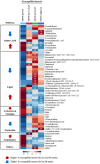Toxicometabolomic profiling of resistant and susceptible western corn rootworm larvae feeding on Bt maize seedlings
- PMID: 35804088
- PMCID: PMC9270432
- DOI: 10.1038/s41598-022-15895-z
Toxicometabolomic profiling of resistant and susceptible western corn rootworm larvae feeding on Bt maize seedlings
Abstract
The western corn rootworm (WCR), Diabrotica virgifera virgifera LeConte, is the most serious pest of maize (Zea mays L.) in the U.S. Corn Belt and parts of Europe. Transgenic maize hybrids expressing at least one of the four currently available insecticidal toxins from Bacillus thuringiensis (Bt) Berliner, currently the most widely adopted control method in continuous maize, have faltered due to the emergence of resistance. The resistance mechanisms of WCR to Bt toxins are not fully understood. We identified metabolic profiles of susceptible and resistant WCR larvae fed on maize hybrids expressing each of three available Cry3 proteins (eCry3Ab1, mCry3A, and Cry3Bb1) targeting corn rootworms and a control non-Bt maize via an untargeted metabolomics approach. Over 580 unique metabolites found in WCR larvae were classified into different pathways (amino acids, carbohydrates, cofactors and vitamins, energy, lipid, nucleotide, peptide, and xenobiotics). By exploring shifts in WCR larval metabolome exclusively by Bt toxins, several candidate metabolites and metabolic pathways were identified in susceptible and resistant larvae that may be involved in defense against or recovery from Bt ingestion by these larvae. These findings would provide mechanistic insights into altered metabolic pathways associated with the resistance mechanisms of WCR to Bt toxins.
© 2022. The Author(s).
Conflict of interest statement
The authors declare no competing interests.
Figures




References
-
- Wechsler S, Smith D. Has resistance taken root in US corn fields? Demand for insect control. Am. J. Agric. Econ. 2018;100:1136–1150. doi: 10.1093/ajae/aay016. - DOI
-
- Culy MD, Edwards CR, Cornelius JR. Effect of silk feeding by western corn rootworm (Coleoptera: Chrysomelidae) on yield and quality of inbred corn in seed corn production fields. J. Econ. Entomol. 1992;85:2440–2446. doi: 10.1093/jee/85.6.2440. - DOI
-
- Ball HJ, Weekman GT. Insecticide resistance in the adult western corn rootworm in Nebraska. J. Econ. Entomol. 1962;55:439–441. doi: 10.1093/jee/55.4.439. - DOI
Publication types
MeSH terms
Substances
LinkOut - more resources
Full Text Sources

